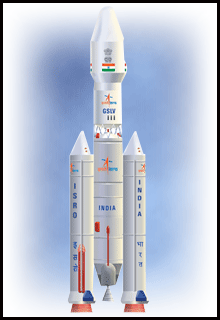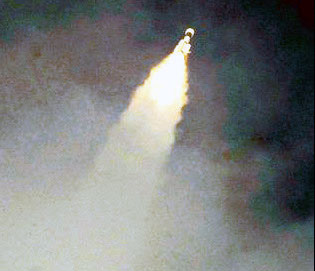|
 The
GSLV D3 rocket blasted off on schedule from the
Sriharikota island space port off the Bay of Bengal
in southern India but minutes later, once it was
at a height of 60 km, it stopped sending signals
and plunged downwards. The first two stages of
conventional solid and liquid fuel rockets performed
well and the third stage cryogenic rocket possibly
ignited. The
GSLV D3 rocket blasted off on schedule from the
Sriharikota island space port off the Bay of Bengal
in southern India but minutes later, once it was
at a height of 60 km, it stopped sending signals
and plunged downwards. The first two stages of
conventional solid and liquid fuel rockets performed
well and the third stage cryogenic rocket possibly
ignited.
But the two small verinier rockets, which analyse
direction parameters in real time and correct
deviations, failed to ignite.
The rocket, with its GSAT-4 communication satellite,
disintegrated and fell into the sea.
The sophisticated cryogenic technology involves
using a combination of liquid oxygen at minus
183 Celsius (-183C) and liquid hydrogen at minus
253 (-253 C). The engineering challenges are apparently
enormous.
India has mastered the conventional rocket technology
by itself and the Indian Space Research Organisation
(ISRO) has even launched satellites for Italy,
Israel and other countries on commercial terms.
For heavier satellites, India has used the EADS
Astrium.
India has been wanting to develop cryogenic technology
for more that 20 years. Its initial attempts were
blocked by the US, but later Russia gave 7 cryogenic
boosters to India without transferring the technology.
Five of these have been used in its GSLV rockets
already since 2001.
Europe’s Astrium, Japan and China are the
other countries with this technology, but as this
is dual use  technology,
none is supposed to share it due to the Missile
Technology Control Regime (MTCR) to which they
are signatories. technology,
none is supposed to share it due to the Missile
Technology Control Regime (MTCR) to which they
are signatories.
Indian scientists have tried to develop the cryogenic
technology on the Russian lines, although many
believe that the US has the best mastery on this.
Today’s launch was the first to send a home-grown
cryogenic rocket. Although experimental, its failure,
and the loss of the onboard satellite, should
put back ISRO by about USD 100 million.
Nonetheless, it was an effort worth as some failures
are part of any development process and all the
countries face some mission failures at some time.
Notwithstanding an odd setback, ISRO has remarkable
success in its overall missions.
The Indian space programme costs less than half
of what the US and Europe spend on comparatively
similar missions.
ISRO Chairman K Radhakrishan said the rocket
“started tumbling and losing altitude, because
two (verinier) engines would not have ignited."
Later however, he said he was not sure if the
main third cryogenic stage ignited or not.
Precious analysis of the data would help find
the problem, and rectify it for future missions.
Data was still being analysed
Success of the ISRO’s GSLV rockets, with
lighter and more powerful cryogenic boosters is
imperative for India’s moon mission as well
as for the capability to put heavy communications
and other satellites of around four tonnes into
orbit.
|